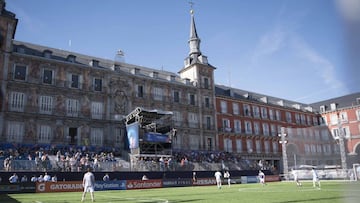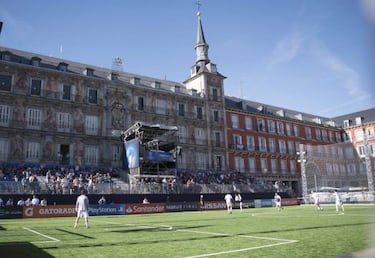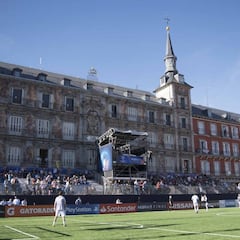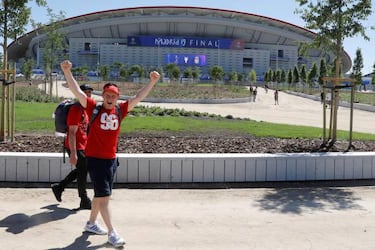Away Days
In this interview published in the official 2019 Champions League final match programme, Madrileño Javier Matallanas takes visiting fans on a footballing tour of his city.

This article appears in the official UEFA Champions League 2019 match programme for the final between Tottenham Hotspur and Liverpool in Madrid on 1 June. The programme has 124 pages full of stats, stories and stunning photography. You can get your own copy from European Nights, the home of UEFA's official club final programmes.
More than just a powerhouse city in world football, Madrid is also a rich destination for any lover of the game. It’s a worthy place of pilgrimage for fans of any club, and I don’t just say that as a proud Madrileño.
The facts speak for themselves, with the Museo del Real Madrid enticing huge numbers of visitors every year; so much so that it is the second most popular museum in all of Spain after the Prado. It is easy to understand why. Located within the Estadio Santiago Bernabéu, this celebration of the 13-time European champions is a must-see, telling the tale of how Alfredo Di Stéfano and Santiago Bernabéu built the most successful club in continental football.
13 European Cups on display
All 13 European Cups are on display at this colossal sporting landmark in Chamartín, north of the city centre. What better way to get a feel for Madrid’s history of success than a tour of the Bernabéu, which takes you down into the changing rooms and out to the pitch? Stop for a meal at the Puerta 57 or Zen Market restaurants and enjoy a view of that famous playing surface, scene of so many epic European nights.

No other team comes close to matching Real Madrid’s continental trophy haul. On top of that, Madrid is the only city to have provided both UEFA Champions League finalists in a single season – and on two separate occasions, in 2014 and 2016. No wonder Madrid can legitimately claim to be the heart of European, and perhaps global, football.
The centre of Spain in the heart of Madrid
The heart of the city itself is the Puerta del Sol. This is the centre circle of Spain, with its Kilómetro Cero (or Km0) plaque marking the spot from which road distances to all other cities are measured. The UEFA Champions Festival is camped out here in the days leading up to the final, sharing the festivities with the nearby Plaza del Callao and Plaza Mayor, which will host the Ultimate Champions match featuring legends from the competition’s past. A short stroll from here are the Plaza de Cibeles, where Madridistas celebrate their side’s trophy wins, and the Fountain of Neptune, the Atlético equivalent.

Speaking of Atlético, the Puerta del Sol also boasts a statue of the bear and strawberry tree that appear on the Colchoneros’ crest – as well as being the symbol of Madrid. When the city was founded in the Middle Ages, these animals roamed the nearby mountains and anyone stepping off the beaten track risked a nasty surprise. The accompanying, less threatening strawberry tree and the coat of arms came later. A second statue of the bear and strawberry tree can be found at Atlético’s Estadio Metropolitano.
Football mad Madrid
You may also want to check out Atleti’s old ground, the Vicente Calderón, at least for an external view. The stadium is in the process of being dismantled, but the surrounding area is worth exploring on foot. The green spaces along the Manzanares river stretch from Legazpi – where the city’s former slaughterhouse has been transformed into the Matadero cultural centre – up to the Casa de Campo, which is the city’s biggest park, and the former Estación del Norte (now known as Príncipe Pío).
The Comunidad de Madrid region has three other Liga teams in Rayo Vallecano, Getafe and Leganés, although you’ll have to go the extra mile to visit the last two as they are based in commuter towns outside the city. Vallecano’s stadium is situated in the working-class area of Vallecas, where a typical Madrileño stew – or cocido – can be sampled at the popular Cruz Blanca restaurant.
To experience matchday like a true Madrid native, one prerequisite is a breakfast of coffee or hot chocolate with Spanish-style doughnuts: churros or porras. The most famous of the cafés making these fried-dough delicacies are Chocolatería San Ginés and Chocolatería Valor.
After that, go for a few beers in a neighbourhood such as Malasaña, a bohemian barrio that became a countercultural hotspot in the 1980s. Each caña (about a third of a pint) is accompanied by a plate of tapas such as patatas bravas (spicy fried potatoes) and oreja a la plancha (pig’s ear). Alternatively, a squid sandwich at the Plaza Mayor never fails!
Final snacks at the Estadio Metropolitano
Related stories

Madrid gears up for Champions League final

UEFA's Champions League Festival is alive in Plaza Mayor
The Estadio Metropolitano has its own Metro station on Line 7, and the culinary experience continues along the Avenida Luis Aragonés outside the stadium with ample chance to pick up a bag of salted sunflower seeds or a sandwich for half-time, typically containing cured ham with tomato and olive oil.

Then all that’s left to do is to enjoy the game in the most football-mad place on earth, a city steeped in the game that produced such iconic players as Raúl González and Fernando Torres. One starred for Madrid and the other for Atleti, but both halves of the capital will be united in pride at staging this UEFA Champions League final.
